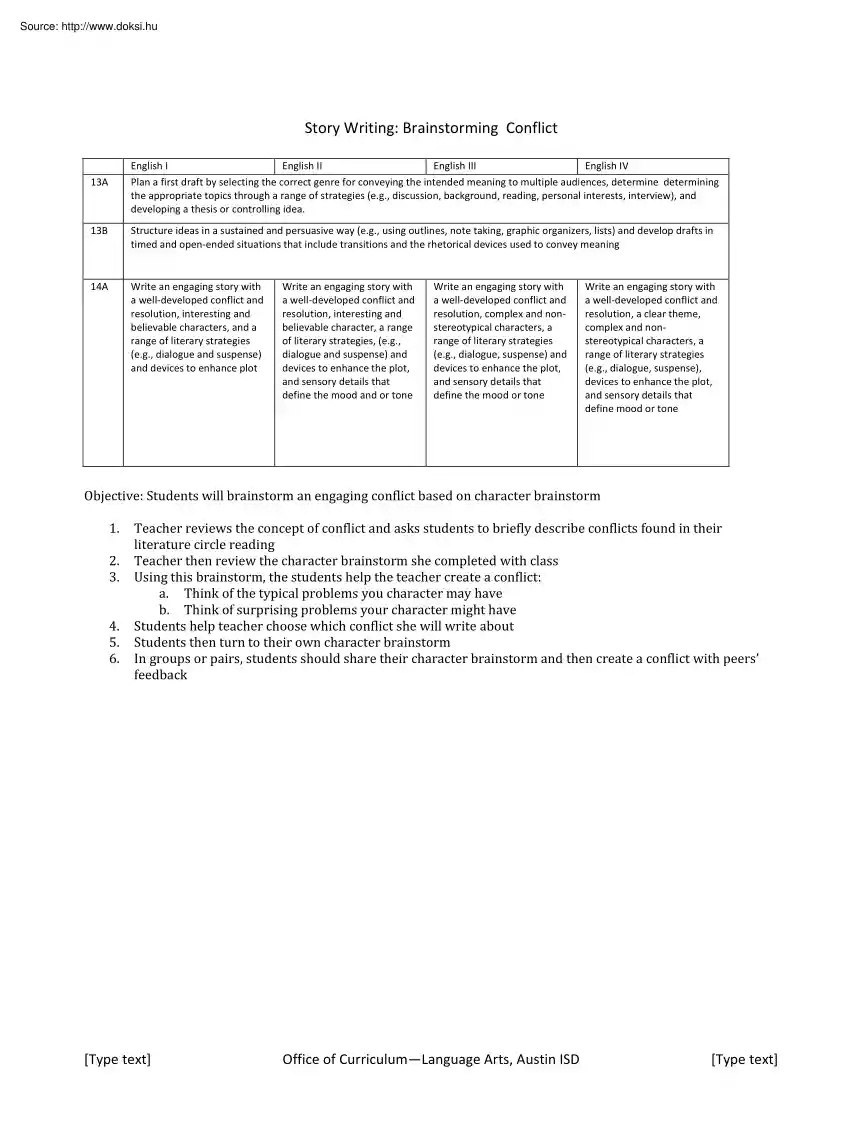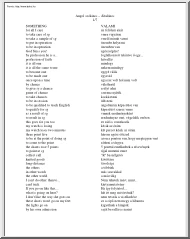Datasheet
Year, pagecount:2012, 1 page(s)
Language:English
Downloads:45
Uploaded:November 24, 2012
Size:70 KB
Institution:
-
Comments:
Attachment:-
Download in PDF:Please log in!
Comments
No comments yet. You can be the first!Most popular documents in this category
Content extract
Story Writing: Brainstorming Conflict English I English II English III English IV Plan a first draft by selecting the correct genre for conveying the intended meaning to multiple audiences, determine determining the appropriate topics through a range of strategies (e.g, discussion, background, reading, personal interests, interview), and developing a thesis or controlling idea. 13A 13B Structure ideas in a sustained and persuasive way (e.g, using outlines, note taking, graphic organizers, lists) and develop drafts in timed and open-ended situations that include transitions and the rhetorical devices used to convey meaning 14A Write an engaging story with a well-developed conflict and resolution, interesting and believable characters, and a range of literary strategies (e.g, dialogue and suspense) and devices to enhance plot Write an engaging story with a well-developed conflict and resolution, interesting and believable character, a range of literary strategies, (e.g, dialogue
and suspense) and devices to enhance the plot, and sensory details that define the mood and or tone Write an engaging story with a well-developed conflict and resolution, complex and nonstereotypical characters, a range of literary strategies (e.g, dialogue, suspense) and devices to enhance the plot, and sensory details that define the mood or tone Write an engaging story with a well-developed conflict and resolution, a clear theme, complex and nonstereotypical characters, a range of literary strategies (e.g, dialogue, suspense), devices to enhance the plot, and sensory details that define mood or tone Objective: Students will brainstorm an engaging conflict based on character brainstorm 1. 2. 3. 4. 5. 6. Teacher reviews the concept of conflict and asks students to briefly describe conflicts found in their literature circle reading Teacher then review the character brainstorm she completed with class Using this brainstorm, the students help the teacher create a conflict: a. Think
of the typical problems you character may have b. Think of surprising problems your character might have Students help teacher choose which conflict she will write about Students then turn to their own character brainstorm In groups or pairs, students should share their character brainstorm and then create a conflict with peers’ feedback [Type text] Office of CurriculumLanguage Arts, Austin ISD [Type text]
and suspense) and devices to enhance the plot, and sensory details that define the mood and or tone Write an engaging story with a well-developed conflict and resolution, complex and nonstereotypical characters, a range of literary strategies (e.g, dialogue, suspense) and devices to enhance the plot, and sensory details that define the mood or tone Write an engaging story with a well-developed conflict and resolution, a clear theme, complex and nonstereotypical characters, a range of literary strategies (e.g, dialogue, suspense), devices to enhance the plot, and sensory details that define mood or tone Objective: Students will brainstorm an engaging conflict based on character brainstorm 1. 2. 3. 4. 5. 6. Teacher reviews the concept of conflict and asks students to briefly describe conflicts found in their literature circle reading Teacher then review the character brainstorm she completed with class Using this brainstorm, the students help the teacher create a conflict: a. Think
of the typical problems you character may have b. Think of surprising problems your character might have Students help teacher choose which conflict she will write about Students then turn to their own character brainstorm In groups or pairs, students should share their character brainstorm and then create a conflict with peers’ feedback [Type text] Office of CurriculumLanguage Arts, Austin ISD [Type text]





